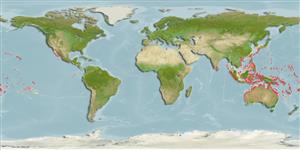>
Ophidiiformes (Cusk eels) >
Dinematichthyidae (Viviparous brotula)
Etymology: Alionematichthys: Name from Latin alius meaning the other or different, and nematichthys, the stem of the genus name Dinematichthys, to which this genus is most similar..
More on author: Alcock.
Environment: milieu / climate zone / depth range / distribution range
Ecologia
marinhas associadas(os) a recifes; intervalo de profundidade 0 - 12 m (Ref. 90102). Subtropical
Eastern Indian Ocean to Western Central Pacific: Andaman Is. to Sumatra, Thailand, Vietnam, Taiwan and the Ryukyu Is., north to Australia (up to Lord Howe I.) and eastwards to Micronesia, Line Is., Tuamotus and Pitcairn Group.
Tamanho / Peso / Idade
Maturity: Lm ? range ? - ? cm
Max length : 8.4 cm SL macho/indeterminado; (Ref. 81230)
Descrição breve
Morfologia | Morfometria
Raios dorsais moles (total): 72-88; Raios anais moles: 55 - 70; Vértebras: 40 - 45. This species is distinguished by the following characters: D 72-88; A 55-70; moderately large eyes (1.7-2.8%SL); slender body; blunt snout, many cirri; cheeks with scales and rarely 1-2 scales above opercular spine; with upper preopercular pore; outer pseudoclasper broad-based, large, often extending beyond hood when in resting position, while the inner one is small, with equal anterior and posterior lobes; otolith length to height 1.9-2.1, with gently curved dorsal rim; otolith length to sulcus length 1.5-1.6, ostium length to caudal length 3.5-4.5; vertebrae 11-12 + 29-33 = 40-45 (Ref. 81230).
Occurs in holes and crevices of coralline and volcanic rock (Ref. 71230). Cryptic and solitary in shallow water (<12 m) (Ref 90102).
Life cycle and mating behavior
Maturidade | Reprodução | Desova | Ovos | Fecundidade | Larvas
Møller, P.R. and W. Schwarzhans, 2008. Review of the Dinematichthyini (Teleostei, Bythitidae) of the Indo-west Pacific, Part IV. Dinematichthys and two new genera with descriptions of nine new species. The Beagle 24:87-146. (Ref. 81230)
Categoria na Lista Vermelha da IUCN (Ref. 130435)
Ameaça para o homem
Harmless
Utilização humana
Mais informação
Nomes comunsSinónimosMetabolismoPredadoresEcotoxicologiaReproduçãoMaturidadeDesovaAgregação para desovaFecundidadeOvosDesenvolvimento dos ovos
Idade/TamanhoCrescimentoComprimento-pesoComprimento-comprimentoFrequência de comprimentoMorfometriaMorfologiaLarvasDinâmica larvarRecrutamentoAbundânciaBRUVS
ReferênciasAquaculturaPerfil para aquaculturaEstirpesGenéticaElectrophoresesHereditariedadeDoençasProcessamentoNutrientsMass conversion
ColaboradoresFotografiasStamps, Coins Misc.SonsCiguateraVelocidadeTipo de nataçãoÁrea branquialOutras referênciasCérebrosVisão
Ferramentas
Relatórios especiais
Descarregue XML
Fontes da internet
Estimates based on models
Preferred temperature (Ref.
123201): 24.3 - 29.3, mean 28.4 °C (based on 2464 cells).
Phylogenetic diversity index (Ref.
82804): PD
50 = 0.5005 [Uniqueness, from 0.5 = low to 2.0 = high].
Bayesian length-weight: a=0.00389 (0.00180 - 0.00842), b=3.12 (2.94 - 3.30), in cm total length, based on all LWR estimates for this body shape (Ref.
93245).
Nível Trófico (Ref.
69278): 3.3 ±0.5 se; based on size and trophs of closest relatives
Fishing Vulnerability (Ref.
59153): Low vulnerability (10 of 100).
Nutrients (Ref.
124155): Calcium = 110 [46, 248] mg/100g; Iron = 0.978 [0.486, 1.879] mg/100g; Protein = 17.5 [14.9, 20.1] %; Omega3 = 0.162 [0.080, 0.318] g/100g; Selenium = 11.3 [4.6, 30.4] μg/100g; VitaminA = 71.8 [18.0, 286.8] μg/100g; Zinc = 1.7 [1.0, 2.7] mg/100g (wet weight);
